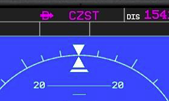I am a student pilot with just a little over 10 hours of flying and
when inclinometer (turn-slip indicator) became for me probably the most important flight instrument along with ASI which I constantly monitor during a flight.
We fly Tecnam P92 with 6-pack and inclinometer is a separate instrument.
However I noticed in newer planes with glass cockpit inclinometer is not always on the screen (you have to push button and select specific page), and also to me integrated inclinometer in G1000 for example not very noticeable.
I don't have any experience with glass cockpit, so I want to ask :
Does an integrated inclinometer in glass cockpit makes harder to read its reading?
-
$\begingroup$ Well, when you move up into one of those planes, you could consider bringing your own-- see hopkinstowingsolutions.com/products/levels/standard-levels/… -- these are only a few inches long and can be stuck on anywhere. Works exactly like the slip-skid ball (except moves in the opposite direction)-- step away from the bubble, step on the ball. $\endgroup$– quiet flyerCommented Sep 1, 2022 at 10:44
1 Answer
The integrated inclinometer on glass cockpit raster displays is called the 'brick'.
As a practical matter, since glass cockpit displays were originally developed for transport airplanes with yaw damper systems, where you don't normally even touch the rudder pedals once airborne unless an engine quits, you don't really use it in maneuvering something like a jet manually, unless you are flying it single engine, which is something you are only ever likely to do in the simulator.
It's not as easy to spot at a glance compared to a large physical skid ball, and it's harder to discern small movements, so having it as the sole reference in a light plane where you have to work your feet constantly, and your head is outside most of the time, can be annoying. You will certainly wish the plane had a large skid indicator at the top of the panel, but in the end you'll just learn to get by with what you have, and glance down at it as you would a regular one.
Of course, you have a giant inclinometer, a big bag of meat with appendages sticking out, just sitting there attached to the bottom of your head. If you are paying attention, you'll notice your own body slouching left or right as the plane slips and skids, the more upright the seating, the better.
Learn to stay relaxed, and sense your own body's leaning tendency when flying, and after a while you'll find you don't even need a skid ball to reference; just use your feet to keep your body straight in the seat.
-
$\begingroup$ John, I apologize in advance for my directness here, but I feel I have to "intervene." Your description intermingles the notion of an inclinometer - a roll meter, with a slip and skid ball - a yaw meter. Yaw and roll have a friendly relationship in the center of the flight envelope, but become dangerous strangers on the fringes. A pilot's misguided belief that one provides useful information about the other is immaterial in normal flight. But in an impending stall, the pilot's inability to intuitively understand yaw separately from roll is a leading cause of fatal accidents. $\endgroup$– Max RCommented Sep 1, 2022 at 14:00
-
$\begingroup$ ... (continued) It is quite a simple matter to place an aircraft in an attitude in which your "meat bag meter" (LOL!) will incorrectly interpret yaw as roll, or roll as yaw, and you would be unable to discern which was causing your sensation without a visual cue. $\endgroup$– Max RCommented Sep 1, 2022 at 14:10
-
1$\begingroup$ Max, an inclinometer in an aircraft is a yaw meter. It measures the inclination of the apparent gravity felt in an aircraft, which is directly caused by sideslip. The meat bag sensor can only measure sideslip, it needs the Mk I eyeballs to measure roll! $\endgroup$ Commented Sep 1, 2022 at 14:13
-
1$\begingroup$ @Max Well, they are integrated into a single display. The brick is part of the roll angle display, the little line below the triangular roll pointer. That IS the skid ball. You have roll attitude and slip skid presented as one pyramid shaped indication. On the old Rockwell Collins Proline glass display, the brick was a rectangular box under the triangle pointer, looking more like an actual brick. $\endgroup$– John KCommented Sep 1, 2022 at 14:25
-
$\begingroup$ @Sanchises Ah, maybe it's my interpretation of the question and answer that went astray. I've never referred to the ball as an inclinometer for exactly the reason you described, because the ball reflects "apparent gravity." I used to work in a field where inclinometer meant something very specific because "actual" gravity was very important. I just have never heard it referred to an inclinometer in aviation. Thanks to both of you for your replies. $\endgroup$– Max RCommented Sep 1, 2022 at 14:43

